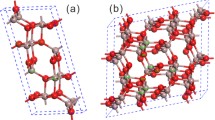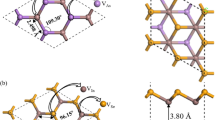Abstract
In this study, we present six structural models for amorphous Ga2O3 (a-Ga2O3) with different mass densities from ab initio molecular dynamics simulations. The detailed local structural order, non-perfect coordination number, electronic and vibrational properties of a-Ga2O3 as well as the energetics and stability of O vacancy with various charge states have been systemically investigated. As the density increases, the first peak in the radial distribution function is weakened and the range of vibrational frequencies is narrowed, while the average coordination number and band gap gradually increase. Density also plays an important role in oxygen vacancy formation in a-Ga2O3. In the low-density a-Ga2O3, oxygen vacancy is more stable and the average formation energy of oxygen vacancy (VO) with neutral state is 3.32–3.70 eV lower than that in crystalline β-Ga2O3 (4.20 eV). In the high-density a-Ga2O3, VO in the 2 + charge state may form spontaneously in the case of lower Fermi energy and the thermodynamic transition energy for VO was found to shift to higher Fermi energy. Hence, the electron trap levels observed in experiment might be correlated with local structural distortion and non-perfect coordination number. Moreover, highly localized valence tail has been observed in all the six a-Ga2O3 systems. Thus, it would be hard to shift the Fermi level to the valence band, leading to rarely observed p-type conductivity in amorphous Ga2O3. These results not only establish a fundamental picture on the origin of a wide range of defect levels in Ga2O3 thin films deposited under different conditions, but also provide useful evidence to identify them with oxygen vacancy states.






Similar content being viewed by others
References
Higashiwaki M et al (2016) Recent progress in Ga2O3 power devices. Semicond Sci Tech 31(3):034001
Pearton SJ et al (2018) A review of Ga2O3 materials, processing, and devices. Appl Phys Rev 5(1):011301
Kyrtsos A, Matsubara M, Bellotti E (2017) Migration mechanisms and diffusion barriers of vacancies in Ga2O3. Phys Rew B 95(24):245202
Qian LX et al (2017) Ultrahigh-responsivity, rapid-recovery, solar-blind photodetector based on highly nonstoichiometric amorphous gallium oxide. ACS Photonics 4(9):2203–2211
Guo DY et al (2017) Evidence for the bias-driven migration of oxygen vacancies in amorphous non-stoichiometric gallium oxide. AIP Adv 7(6):065312
Liang H, et al. (2018) Flexible X-ray detectors based on amorphous Ga2O3 thin films. ACS Photonics 6(2):351–359
Kobayashi E et al (2018) Amorphous gallium oxide grown by low-temperature PECVD. J Vac Sci Technol A 36(2):021518
Cui S et al (2017) Room-temperature fabricated amorphous Ga2O3 high-response-speed solar-blind photodetector on rigid and flexible substrates. Adv Opt Mater 5(19):1700454
von der Heiden A et al (2019) Oxygen diffusion in amorphous and partially crystalline gallium oxide. Phys Chem Chem Phys 21(8):4268–4275
Aoki Y et al (2014) Bulk mixed ion electron conduction in amorphous gallium oxide causes memristive behaviour. Nat. Commun. 5:3473
Zhang F et al (2018) Evolution of optical properties and band structure from amorphous to crystalline Ga2O3 films. AIP Adv 8(4):045112
Heinemann MD et al (2016) Oxygen deficiency and Sn doping of amorphous Ga2O3. Appl Phys Lett 108(2):022107
Zhou T et al (2016) Enhanced yellow luminescence of amorphous Ga2O3 nanofibers with tunable crystallinity. Ceram Int 42(5):6467–6474
Shi Q et al (2019) Structural, optical and photoluminescence properties of Ga2O3 thin films deposited by vacuum thermal evaporation. J Lumin 206:53–58
Lee SH et al (2017) High-responsivity deep-ultraviolet-selective photodetectors using ultrathin gallium oxide films. ACS Photonics 4(11):2937–2943
Han S et al (2019) High-performance UV detectors based on room-temperature deposited amorphous Ga2O3 thin films by RF magnetron sputtering. J Mater Chem C 7(38):11834–11844
Nagarajan L et al (2008) A chemically driven insulator–metal transition in non-stoichiometric and amorphous gallium oxide. Nat. Mater. 7:391
Kresse G, Furthmüller J (1996) Efficiency of ab-initio total energy calculations for metals and semiconductors using a plane-wave basis set. Comp Mater Sci 6(1):15–50
Kresse G (1995) Ab initio molecular dynamics for liquid metals. J Non-Cryst Solids 192–193:222–229
Perdew JP, Burke K, Ernzerhof M (1996) Generalized Gradient Approximation Made Simple. Phys Rev Lett 77(18):3865–3868
Heyd J, Scuseria GE, Ernzerhof M (2003) Hybrid functionals based on a screened Coulomb potential. J Chem Phys 118(18):8207–8215
Heyd J, Scuseria GE, Ernzerhof M (2006) Hybrid functionals based on a screened Coulomb potential. J Chem Phys 124(21):219906
Sun D et al (2019) Defect stability and electronic structure of doped β-Ga2O3: a comprehensive ab initio study. J Alloy Compd 794:374–384
Nosé S (1984) A unified formulation of the constant temperature molecular dynamics methods. J Chem Phys 81(1):511–519
Yu Z et al (2003) Growth and physical properties of Ga2O3 thin films on GaAs(001) substrate by molecular-beam epitaxy. Appl Phys Lett 82(18):2978–2980
Passlack M et al (1995) Ga2O3 films for electronic and optoelectronic applications. J Appl Phys 77(2):686–693
Weast RC, Astle MJ, Beyer WH (1988) CRC handbook of chemistry and physics, vol 69. CRC Press, Boca Raton
Varley JB et al (2010) Oxygen vacancies and donor impurities in β-Ga2O3. Appl Phys Lett 97(14):142106
Yang H et al (2019) Surface/structural characteristics and band alignments of thin Ga2O3 films grown on sapphire by pulse laser deposition. Appl Surf Sci 479:1246–1253
Haerle R, Pasquarello A, Baldereschi A (2001) First-principle study of C 1s core-level shifts in amorphous carbon. Comp Mater Sci 22(1–2):67–72
Grundmann M (2010) Physics of semiconductors, vol 11. Springer, Berlin
Cohen MH, Fritzsche H, Ovshinsky SR (1969) Simple band model for amorphous semiconducting alloys. Phys Rev Lett 22(20):1065–1068
Durandurdu M (2017) Amorphous zirconia: ab initio molecular dynamics simulations. Philos Mag 97(16):1334–1345
Cai B, Drabold DA (2011) Properties of amorphous GaN from first-principles simulations. Phys Rew B 84(7):075216
Robertson J (2008) Physics of amorphous conducting oxides. J Non-Cryst Solids 354(19):2791–2795
Inam F, Lewis JP, Drabold DA (2010) Hidden structure in amorphous solids. Phys Status Solidi A 207(3):599–604
Deák P et al (2017) Choosing the correct hybrid for defect calculations: a case study on intrinsic carrier trapping in β-Ga2O3. Phys Rew B 95(7):075208
Gake T, Kumagai Y, Oba F (2019) First-principles study of self-trapped holes and acceptor impurities in Ga2O3 polymorphs. Phys Rew Mater 3(4):044603
Machon D et al (2006) High-pressure study of the β-to-α transition in Ga2O3. Phys Rew B 73(9):094125
Polyakov AY et al (2018) Defects responsible for charge carrier removal and correlation with deep level introduction in irradiated β-Ga2O3. Appl Phys Lett 113(9):092102
McGlone JF et al (2019) Identification of critical buffer traps in Si δ-doped β-Ga2O3 MESFETs. Appl Phys Lett 115(15):153501
Polyakov AY et al (2019) Hydrogen plasma treatment of β-Ga2O3: Changes in electrical properties and deep trap spectra. Appl Phys Lett 115(3):032101
Farzana E et al (2018) Impact of deep level defects induced by high energy neutron radiation in β-Ga2O3. APL Mater 7(2):022502
Polyakov AY et al (2019) Defects at the surface of β-Ga2O3 produced by Ar plasma exposure. APL Mater 7(6):061102
Dong L et al (2017) Effects of oxygen vacancies on the structural and optical properties of β-Ga2O3. Sci Rep 7:40160
Polyakov AY et al (2019) Deep trap spectra of Sn-doped α-Ga2O3 grown by halide vapor phase epitaxy on sapphire. APL Mater 7(5):051103
Jeon D-W et al (2018) Electrical properties, structural properties, and deep trap spectra of thin α-Ga2O3 films grown by halide vapor phase epitaxy on basal plane sapphire substrates. APL Mater 6(12):121110
Acknowledgements
This work was supported by the Science Challenge Project (TZ2018004), the National Natural Science Foundation of China (11874097) and the Fundamental Research Funds for the Central Universities of China (DUT19LK12). The authors also acknowledge the Supercomputing Center of Dalian University of Technology for providing the computing resources.
Author information
Authors and Affiliations
Corresponding authors
Additional information
Publisher's Note
Springer Nature remains neutral with regard to jurisdictional claims in published maps and institutional affiliations.
Rights and permissions
About this article
Cite this article
Sun, D., Gao, Y., Xue, J. et al. Matching vacancy formation energy and defect levels with the density of amorphous Ga2O3. J Mater Sci 55, 9343–9353 (2020). https://doi.org/10.1007/s10853-020-04713-4
Received:
Accepted:
Published:
Issue Date:
DOI: https://doi.org/10.1007/s10853-020-04713-4




